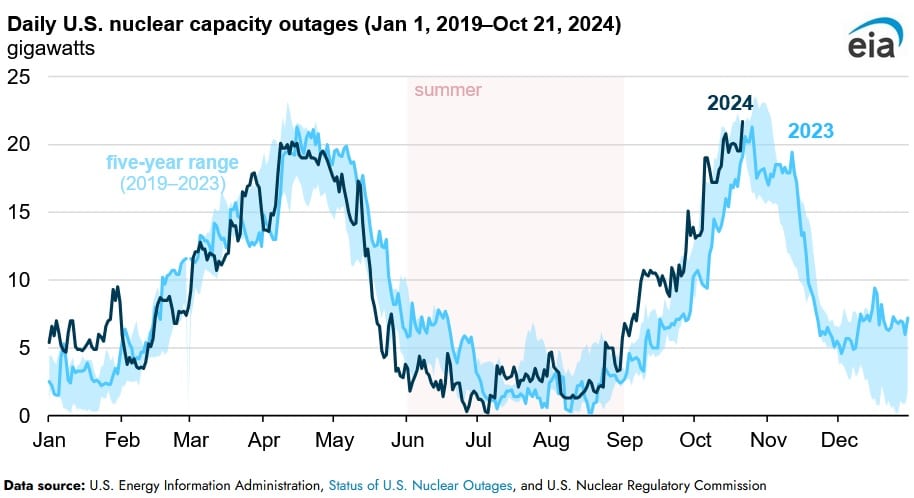U.S. Nuclear Capacity Outages Declined During Summer 2024: EIA

Average U.S. nuclear capacity outages declined to around 2.6 gigawatts (GW) per day during summer 2024, down 0.5 GW compared to summer 2023, according to an Nov. 5 report published by the U.S. Energy Information Administration. U.S. nuclear capacity outages were mostly evident in mid-July and early August, averaging 3.1 GW per day during the period and hitting a high of 5.7 GW on August 31. Despite the year-on-year reduction, nuclear outages have surpassed the five year average due to refuelling outages and weather related interruptions.
Nuclear power assets undergo both planned and unplanned outages. Planned outages transpire due to required maintenance and refuelling and often take place during periods of low demand. In contrast, unplanned outages occur as a result of weather-related interruption, early retirements or technical issues such as equipment failure and can impact the U.S. electricity generation mix significantly during periods of high demand, particularly during the winter months. The fewest nuclear outages usually occur during the summer and winter because electricity demand is highest during these seasons and plant operators need to have reactors available to fulfil higher seasonal electricity demand.
As of Oct. 21, 2024, the U.S. has experienced 39 nuclear outages during this year, in comparison to 55 during 2023. Waterford Unit 3 in Louisiana underwent the longest unplanned outage which lasted 59 days. The outage was due to two transformers catching fire on Mar. 22. The two longest unplanned outages during summer 24 occurred at the Oconee Unit 3 in South Carolina and Watts Bar Unit 1 in Tennessee. The Oconee Unit 3 endured an unplanned outage which lasted 16 days, whilst the Watts Bar Unit 1 unplanned outage lasted 11 days. Meanwhile, Hurricane Helene during the back end of September led to electricity outages throughout the Southeast. The operations at the Hatch Nuclear Plant in Georgia and Catawba Nuclear Station in North Carolina were negatively affected.
Planned nuclear generation outages are typically planned to concur with reactor refueling cycles. U.S. nuclear power plants usually refuel reactors every 18 to 24 months, mainly in fall and spring when electricity demand is lower. During a refueling outage, plants usually optimize downtime by planning repairs, facility upgrades, and other maintenance work while the nuclear reactor is offline. As of July 31, U.S. nuclear plant refueling outages during 2024 have lasted an average of 34 days compared with an average of 38 days in 2023.
During the back end of 2024, the U.S. nuclear fleet is projected to complete a number of refueling outages that commenced in September and October.
EnerKnol Pulses like this one are powered by the EnerKnol Platform—the first comprehensive database for real-time energy policy tracking. Sign up for a free trial below for access to key regulatory data and deep industry insights across the energy spectrum.
ACCESS FREE TRIAL